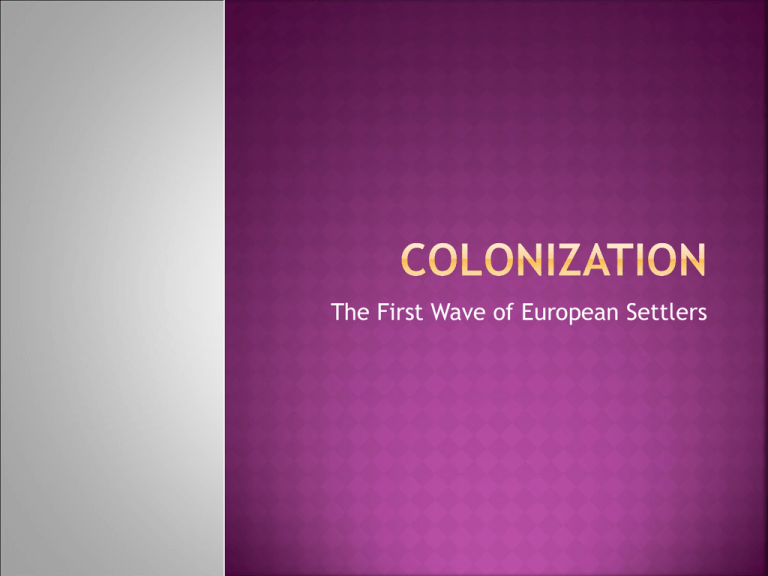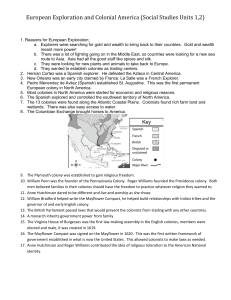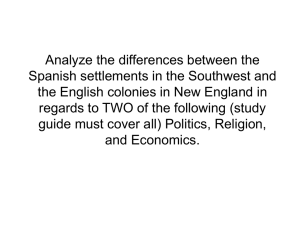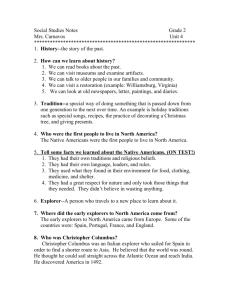Colonization
advertisement

The First Wave of European Settlers COLONIZE to settle a “new” land; to build settlement(s) in previously unsettled territory Geographically, what areas of the New World were western Europeans interested in settling? What motivated western European powers (France, the Netherlands, England, Spain, and Portugal) to migrate and settle the New World? How did these European powers differ in their colonization plans? What conflicts arose over competition for land acquisitions in the New World? What were the effects of European colonization on the native peoples of the Americas? How did European colonization fuel the Atlantic Slave Trade? Which label(s) best describes the very first wave of European immigrants to the Americas: explorers, missionaries, merchants, or conquerors? Florida (USA) Southwestern USA Mexico Guatemala Belize Honduras El Salvador Nicaragua Costa Rica Panama Cuba Dominican Republic Puerto Rico Jamaica Columbia Venezuela Trinidad and Tobago Ecuador Peru Bolivia Chile Argentina Uruguay Paraguay These People were found by them to be Wise, Grave, and well dispos’d, though their usual Butcheries and Cruelties in opressing them like Brutes, with heavy Burthens, did rack their minds with great Terror and Anguish. At their Entry into a certain Village, they were welcomed with great Joy and Exultation, replenished them with Victuals, till they were all satisfied, yielding up to them above Six Hundred Men to carry their Bag and Baggage, and like Grooms to look after their Horses: The Spaniards departing thence, a Captain related to the Superiour Tyrant returned thither to rob this (no ways diffident or mistrustful) People, and pierced their King through with a Lance, of which Wound he dyed upon the Spot, and committed several other Cruelties into the bargain. In another Neighboring Town, whose Inhabitants they thought, were more vigilant and watchful, having had the News of their horrid Acts and Deeds, they barbarously murdered them all with their Lances and Swords, destroying all, Young and Old, Great and Small, Lords and Subject without exception. Vocabulary: disposed: killed, dead brutes: beast like burthens: old form of the word burden anguish: hardships exultation: joy, happiness victuals: food diffident: shy, timid vigilant: guarding, watchful According to sixteenth-century historian Bartolome de Las Casas, how did the Spanish treat the indigenous people they encountered in the New World? How does the drawing in the Las Casas book display the Spanish? How does it display the indigenous people? Identify three figures wearing different types of clothing in this painting. Attempt to give them a job title or character title. What items in this painting display power? What items in this painting display religion? How can this painting relate to what motivated the Spanish to explore and colonize the New World? 1. “Conquista” – conquest. Spain wanted to grab as much territory as it could as quickly as it could. 2. Trade – particularly gold, silver, and agricultural products. The Spanish acquired so much silver it led to inflation, sowing the seeds for financial disaster in Spain. 3. Glory – Early Spanish explorers and settlers were keenly aware of the historical nature of their endeavors. They were ambitious and eager to please their monarchs and to gain wealth. 4. Spread of Christianity – Spanish conquistadors felt it was their duty to convert the natives of the Americas to Christianity. Once the Spanish became aware of some of the native religious customs (such as human sacrifice), they felt justified to conquer and convert by any means necessary. The Spanish established “missions” – religious outposts throughout their territories – with the goal of propagating Roman Catholicism. “The Black Legend” – Spain became notorious for the atrocities committed by conquistadors against Native Americans. Many Spanish missionaries criticized the conquistadors for their severe acts. Slavery – The Spanish were the first to use slaves in the New World. Disease – Within one generation of Columbus’s arrival, as much as 90% of the native populations of Central America and the Caribbean Islands died of European diseases. Roman Catholicism – Although their missionary tactics were often extreme, Christianity, and particularly Roman Catholicism, became and remains the dominant religion of Mexico, Central America, and South America. There are more Roman Catholics in South America than on any other continent. Pope Francis is Argentine. Language – Spanish is the official language of 20 nations in the Western Hemisphere, and is a significant minority language in the USA and Belize. With approximately 470 million people speaking Spanish as their native tongue, it is the most widely understood language in the Western Hemisphere. Only Mandarin Chinese claims more native speakers than Spanish. Influence – Spain continued to hold territories in the Western Hemisphere and around the world until around the turn of the 20th century, when its empire began to seriously wane. Brazil Uruguay Southern and eastern Canada Central USA – From the Great Lakes in the north to the Appalachian Mountains in the east to the Gulf Coast of Louisianan in the south to the Rocky Mountains in the west. French Guiana Haiti Martinique Who was Jacques Cartier, and what did he do? Why wasn’t France in a good position to begin colonization of the New World during the 1500s? Who is considered the “Father of New France”? Why? When and where was France’s first permanent New World settlement founded? Describe the relationship between French settlers and the Native Americans. How do French relations with Native Americans differ from Spanish and English relations with Native Americans? What two groups were most instrumental in the expansion of New France? Why did New France expand so slowly? Compare and contrast New France with the English colonies in America. Describe the government of New France. How did France eventually lose its North American territories? Trade – France, through favorable relations with several Native American tribes, developed an extensive trade network, based mainly on the fur trade. Spread of Christianity – Jesuit missionaries had little success in converting natives, but their missionary expeditions helped France map out the vast territories. Native American relations – Unlike the Spanish (who generally conquered, killed, and enslaved natives) and the English (who generally warred with the natives over territory, eventually displacing them), the French were able to develop mostly positive relations based on trade and military alliances. Keeping up with the Jones – France understood that having a significant presence in the New World was key to keeping pace with the growing power of its chief rivals, Spain and (especially) England. Language – French is one of two official languages of Canada. Over 10 million Canadians speak French, most of them in the province of Quebec. French is also spoken in small areas of Louisiana and New England. Permanent settlements – Although France’s presence in North America lasted only about 150 years, the French established numerous settlements that not only lasted but became major cities: Montreal, Detroit, St. Louis, Chicago, and New Orleans all started as French trading posts. Take that, England! – After the English defeated France in the French and Indian War in 1763, France lost all its territory in North America. Keen for revenge, France was more than happy to help the American colonists fight the English in the War for American Independence. With France’s naval support, England was defeated and lost a significant chunk of its North American territory, though England still kept possession of its Canadian territory, including what was once part of New France. Northern Canada and the Arctic Islands Nova Scotia, New Brunswick, and St. Pierre et Miquelon (Canada) The Atlantic coast of the USA Following the British defeat of France in the French and Indian War (1754-1763), Great Britain gained control of all of North America east of the Mississippi River. Bahamas Virgin Islands England’s Approach: Merchants, Conquerors Trade – The English are primarily concerned with making money from their New World colonies. Originally, they hope to find gold and silver (like the Spanish), but they ultimately get rich off of cash crops like tobacco, sugar, rice, and indigo. Conquest – England hopes to gain as much territory as possible, mainly in order to make money and keep up with their European rivals (Spain and France). Relations with Native Americans – While England formed early alliances with some tribes, their relations with Native Americans were primarily hostile. The English weren’t really interested in converting the Natives to Christianity; they were interested in land acquisition. The English, as they claimed more and more land, displaced the Natives, forcing them westward. Three Charter Colony – The monarch grants a charter (a list of rules governing the colony) to colonists. Example: Connecticut Proprietary Colony – One or more individuals (wealthy landowners) are given virtually free rule over the colony. This ruler was called a Lord Proprietor, and the title was passed to an heir after death. types of English Colonies: Example: Pennsylvania and Carolina Who were Carolina’s original Lords Proprietor? Royal (Crown) Colony – The monarch appointed a governor to lead the colony. Most proprietary colonies eventually became royal colonies. Example: Maryland New England Colonies Massachusetts, New Hampshire, Connecticut, Rhode Island Poor, rocky soil and a cool climate made large-scale agriculture difficult. Reason the first settlers came: Religious Freedoms Middle Colonies New York, New Jersey, Pennsylvania, Delaware Settlers came for assorted reasons ranging from economic opportunity to religious freedom. Settlers came from England, Germany, France, the Netherlands, and Scandinavia. New York and Philadelphia rapidly became major population and shipping centers. The Southern Colonies Maryland, Virginia, North Carolina, South Carolina, Georgia These colonies were settled for primarily economic reasons. The warm climate and fertile soil made these colonies ideal for growing cash crops such as tobacco, sugar cane, rice, and indigo. Land was divided into large plantations which were worked by slaves and indentured servants. North Carolina, with its vast pine forests, became a leading producer of lumber, tar, and pitch. NC was also a major producer of indigo and tobacco. The Foundations of American Liberty Documents such as the Mayflower Compact and colonial charters were important in spelling out the rights and responsibilities of colonial citizens. These documents laid the groundwork for the US Constitution, the Bill of Rights, and the Declaration of Independence. Though the colonies were ultimately ruled by the British Crown, they were allowed some freedom to govern themselves through representative democracy. Colonists elected representatives to represent them in legislative assemblies such as the House of Burgesses. The Beginning of the End Prior to the 1760s, most American colonists were more than content to be British subjects. After all, Great Britain was the most powerful empire in the world; Americans enjoyed the benefits of the wealthy British economy and the protection of the British military. In 1763, Great Britain defeated France in the French and Indian War (AKA the Seven Years War), taking most of France’s North American territory. Sounds like good news for British subjects, right? Actually, though winning a war is better than losing, it is still super expensive, so victorious Great Britain emerged from the war with huge debts. Their solution? Tax the colonies. The Beginning of the End The British Parliament passed two acts – the Stamp Act (1765) and the Townsend Acts (1767) – which levied taxes on all legal documents and most imported goods, such as tea. The colonists felt that these acts violated their rights as British citizens, since these acts were passed in Parliament and not by their own colonial governments. The colonists protested these taxes in a number of ways for the next ten years. “No taxation without representation” became a rallying cry in the colonies. Gradually, more and more colonists felt that they should either be represented in Parliament or be completely free to govern themselves. Language – English is the predominant language of the U.S. and Canada, and is the most widely understood language in the world. Slavery – English colonists brought hundreds of thousands of African slaves to North America, establishing what would become America’s most prominent and enduring cultural defect—racism. Ironically, Great Britain was one of the first western nations to mount a campaign against international slavery. Abolitionism began to gain steam in Britain as early as the 17th century. Culture – The cultures of the US, Canada, and the UK are very similar. Apart from sharing a common language, we share similar tastes in film, music, art, etc. We also have very similar ideas about human rights and the ways in which societies should be organized. Americans have fought two wars against the British (and nearly fought a third), but from the early 20th century on, America and the UK have been close allies. Guyana Suriname Alaska (USA) Pacific Coast of Canada




